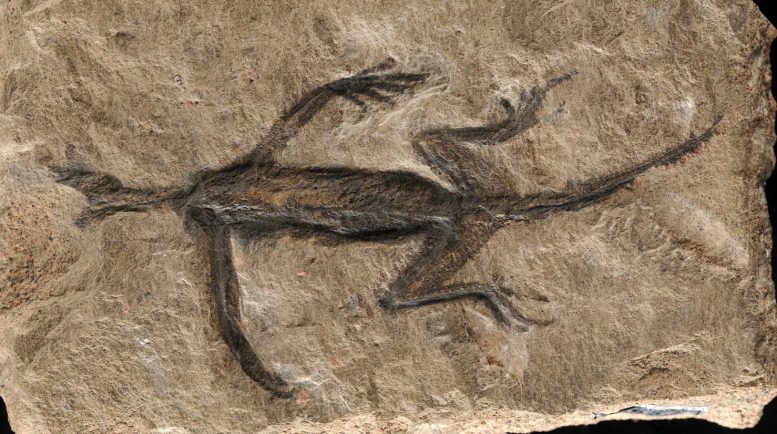Home Science News
By James Ashworth, Natural History Museum February 26, 2024

Tridentinosaurus antiquus was discovered in the Italian Alps in 1931 and was thought to be an important specimen for understanding early reptile evolution — but has now been found to be, in part a forgery. Its body outline, appearing dark against the surrounding rock, was initially interpreted as preserved soft tissues but is now known to be paint. Credit: Dr. Valentina Rossi
Recent research has shown that the Tridentinosaurus antiquus fossil, once thought to contain preserved skin, is actually a forgery with painted “soft tissues,” highlighting the need for caution in paleontological research.
Preserved skin in a 280-million-year-old fossil may not be all that it seems.
New research has found that soft tissue in Tridentinosaurus antiquus is a forgery and warns against using the reptile in future research.
The importance of an ancient reptile fossil appears to be less than skin deep.
Historic Deception Unveiled
Discovered in the Alps in the 1930s, Tridentinosaurus antiquus was believed to be a rare fossil with its skin still preserved. However, a new study of the fossil suggests that it isn’t skin at all – but black paint.
Rather than offering an insight into early reptiles, Tridentinosaurus is seemingly evidence of a historic forgery. While the identity of the alleged culprit isn’t known, the researchers believe they carved the outline of a reptile around a few small leg bones, before painting the ‘soft tissue’ over the top.
While these leg bones appear to be genuine fossils, they’re not well preserved enough to reveal what Tridentinosaurus actually is.
Dr. Valentina Rossi, the lead author of the research published in the journal Palaeontology, says, “Fossilised soft tissues are rare, but can reveal important biological information about a species, like its external coloration, internal anatomy and physiology.”
“We hoped that the answer to all our questions about Tridentinosaurus was right in front of us, and so we studied the fossil specimen in detail to reveal its secrets, even those that, perhaps, we did not want to know.”
Dr. Marc Jones, the Natural History Museum’s Curator of Fossil Reptiles, adds, “This study highlights the importance of modern imaging techniques for carefully verifying apparent soft tissue remains in historical specimens.”
Getting Under the Skin
Since the discovery of Tridentinosaurus in 1931, the ancient reptile has posed a puzzle for scientists. While the fossil preserved very few bones, large parts of the animal’s skin appeared to have survived.
Though preserved soft tissues aren’t unknown in fossils, with mummified dinosaurs occasionally coming to light, they are extremely rare. Tridentinosaurus was even more unusual because its skin was thought to have been preserved by carbonization.
This is a process that normally only happens in plant fossils, where the plant’s tissues are converted into a thin and fragile layer of carbon. But as Tridentinosaurus was found among carbonized plants, researchers were not immediately suspicious of its origins.
Based on its shape, Tridentinosaurus was thought to be a type of animal called a protorosaur, a very early relative of birds, crocodiles, and dinosaurs. Having been kept in an Italian museum for many years, the researchers were keen to use the latest analytical techniques to see what the fossil might reveal about these animals.
In particular, being able to sample the skin could have revealed more about the ancient reptile’s lifestyle and anatomy, and perhaps its relatives.
With this in mind, the researchers took small samples of the fossil to study. The initial results were promising, revealing the presence of small scales known as osteoderms on the back of the animal. However, the other tests on Tridentinosaurus made the researchers suspicious of its soft tissue.
The team exposed Tridentinosaurus and a plant fossil found near it to UV light, causing the outline of Tridentinosaurus’ to become fluorescent while the plant stayed the same. Fossilized soft tissue doesn’t normally fluoresce, but certain pigments, varnishes, and glues do.
The outline was also surprisingly grainy for what was supposed to be soft tissue, while there were no chemical traces of fossilized melanin, the natural pigments that color hair, skin, and eyes. While tests on the chemical makeup of the layer were less conclusive, they were still consistent with a black paint being applied to the fossil.
As the description of the species was based on the shape of the body outline, the research calls Tridentinosaurus into doubt. The leg bones lack specific features that would separate this animal from its relatives, meaning it may not be a species in its own right.
However, as CT scans haven’t been carried out on the fossil, it’s possible that more helpful bones might exist under the surface of the rock. Until then, the scientists suggest that Tridentinosaurus is left out of future research on ancient reptiles.
For more on this story, see The 280-Million-Year-Old Fossil That Fooled Scientists for Decades.
Reference: “Forged soft tissues revealed in the oldest fossil reptile from the early Permian of the Alps” by Valentina Rossi, Massimo Bernardi, Mariagabriella Fornasiero, Fabrizio Nestola, Richard Unitt, Stefano Castelli and Evelyn Kustatscher, 15 February 2024, Palaeontology.
DOI: 10.1111/pala.12690
>>> Read full article>>>
Copyright for syndicated content belongs to the linked Source : SciTechDaily – https://scitechdaily.com/deception-in-paleontology-the-painted-skin-on-a-280-million-year-old-fossil/
















![[News] Japan Develops 10nm Nanoimprint Technology, with Potential to Tackle EUV Bottleneck – TrendForce](https://earth-news.info/wp-content/uploads/2025/12/329851-news-japan-develops-10nm-nanoimprint-technology-with-potential-to-tackle-euv-bottleneck-trendforce-360x180.jpg)














